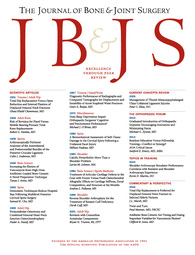
TRAUMA
Similar clinical outcomes with plating or nailing for midshaft clavicle fractures
This report has been verified
by one or more authors of the
original publication.
J Bone Joint Surg Am. 2015 Apr 15;97(8):620-6.
59 patients with displaced midshaft clavicular fractures were randomly assigned to treatment with either a reconstruction plate or an elastic stable intramedullary nail. The study was conducted with the primary intention of identifying differences in functional outcome as evaluated by Disabilities of the Arm, Shoulder and Hand (DASH) and Constant-Murley scores, 6 and 12 months postoperatively. Other parameters such as time to fracture union, residual shortening, pain, and complications were also assessed within the same time frame. The study found that both treatments displayed similar levels of efficacy, with the exception of the elastic stable intramedullary nail procedure being more susceptible to implant-related pain, and the plate fixation procedure being more susceptible to implant blending when appropriate bone support was not achieved.
Unlock the full ACE Report
You have access to {0} free articles per month.Click below to unlock and view this {1}
Unlock NowCritical appraisals of the latest, high-impact randomized controlled trials and systematic reviews in orthopaedics
Access to OrthoEvidence podcast content, including collaborations with the Journal of Bone and Joint Surgery, interviews with internationally recognized surgeons, and roundtable discussions on orthopaedic news and topics
Subscription to The Pulse, a twice-weekly evidence-based newsletter designed to help you make better clinical decisions
Exclusive access to original content articles, including in-house systematic reviews, and articles on health research methods and hot orthopaedic topics
Or upgrade today and gain access to all OrthoEvidence content for just $1.99 per week.
Already have an account? Log in


Subscribe to "The Pulse"
Evidence-Based Orthopaedics direct to your inbox.
{0} of {1} free articles
Become an OrthoEvidence Premium Member. Expand your perspective with high-quality evidence.
Upgrade Now













































































